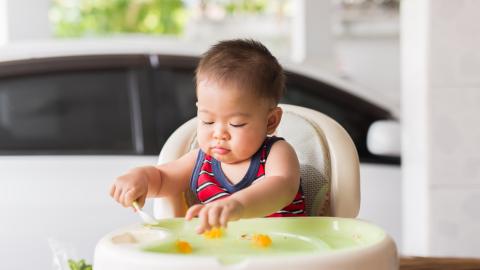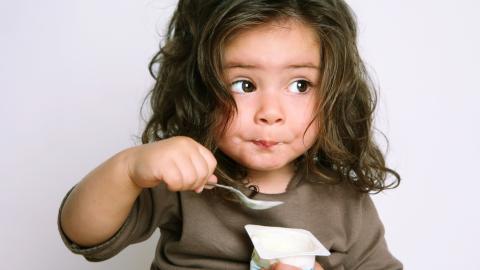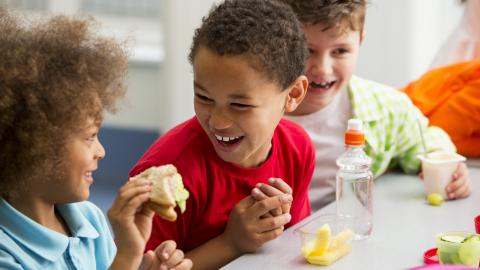Resource
Eating & nutrition for toddlers

Eating is an excellent way for toddlers to develop new skills and learn more about the world. They start to take a more active role in family meals. One of the most important things you can do is learn to trust your toddler to decide how much and whether or not to eat what you provide. When you do your job with feeding, they will do their job with eating. Let your children grow up to get the right bodies for them.
Tips for feeding your toddler
- You decide what, where and when to serve food. Your child decides if they are going to eat and how much.
- Continue to offer a variety of foods from the categories in Canada's Food Guide.
- Create a mealtime routine with three meals and two to three snacks each day.
- Keep your toddler from having food or beverages (except for water) between meal and snack times.
- Expect a mess! Toddlers are learning to eat and explore the world with all their senses.
- Set limits. Your child may start to ask for unhealthy choices like pop or candy. It is your job to say "no."
- When letting your toddler feed themselves, ensure it's safe for them. Your toddler is still learning how to eat.
Challenging eating behaviours
Your toddler will start showing some eating behaviour that may be challenging. Keep in mind that it's normal. Your toddler may:
- Eat a lot one day and only a little the next.
- Refrain from eating a food that they have always eaten before.
- Want to eat the same food every day for a week.
- Be easily distracted and take a long time to finish eating.
- Play with their food.
You can help make mealtime successful.
- Let your toddler feed themselves. Let them try using a fork or spoon.
- Never let your toddler eat while running around. If they sit while they eat, it will help prevent choking.
- Never force your child to eat.
- Make meal times fun!
- Be a good role model. Eating healthy foods will make your toddler more likely to want to eat them too.
- Have set meal and snack times; don't offer food on demand.
Learn more about feeding your toddler (1-3 years) - Available in English, Chinese Traditional, Punjabi, Vietnamese, Spanish, Korean, Farsi,
Food safety
When making food for your child, practice safe food handling and remember that your child is still learning to eat.
- Cut-up finger foods that could be a choking hazard
- Avoid big globs of gooey foods like peanut butter and melted cheese
For information on safe food handling to prevent food poisoning, visit the food safety at home webpage.
Snacks & meals
Use Canada's Food Guide to decide what food to prepare for meals and snacks.
- It recommends including plenty of vegetables and fruit, eating good protein foods (including choosing plant-based proteins more often) and making water your drink of choice.
- Each meal should include about:
- Half of your plate filled with vegetables and fruits
- ¼ of your plate with a healthy protein (such as legumes, lean meats)
- ¼ of your plate with whole grain foods (such as whole grain pasta, quinoa, whole grain or brown rice)
- Snacks can be a combination of at least two different food categories.
- Prepare foods using as little added salt and sugar as possible.
What to drink
Introducing cups
As you introduce drinks other than breastmilk to your toddler, you can offer them in an open cup. You might have to help them learn how to use an open cup. Experts do not recommend sippy cups because your toddler needs to suck to drink and doesn’t learn the right drinking skills.
Milk
Breast milk or cow milk is integral to your child’s diet. You can continue breastfeeding, switch to cow’s milk, or combine the two.
- You can breastfeed your child until they are two years old or older.
- The kind of milk you give can be breast milk, whole milk (3.25% M.F.), or a mix of both.
- If you are using evaporated or powdered milk, choose a full-fat type that is adequately diluted or reconstituted.
- If you’re using cow milk, offer 2 cups (500 mL) but not more than 3 cups (750 mL) per day.
- If your child is breastfed or not drinking 500 mL of milk, give 400 IU of Vitamin D daily.
- If your family drinks lower-fat milk (e.g., 2%, 1%, skim milk), you can switch to them after two years old.
- Soy “milk” and other “milk” drinks do not have enough fat or protein to meet a toddler’s needs. Experts recommend a soy-based commercial infant formula for children who are no longer breastfeeding or have not had cow milk. This “milk” includes rice, almond, coconut, and potato.
Juice
Your toddler doesn’t need juice to be healthy. Juice has a lot of sugar, and you can avoid it entirely. Offer water between meals and snacks. If you do decide to give juice:
- Give juice with no added sugar
- Offer it in an open cup as part of a meal or snack
- Limit it to no more than 125 ml (½ cup) per day
- Use a small amount of juice and add a more significant amount of water before handing it to your child
Bye-bye baby bottle
Benefits of drinking from a cup
By the time your baby is 18 months old, you should get rid of the baby bottle and only let them drink from a cup. Sometimes that transition can be a struggle, but giving up the bottle means that your child:
- Is at lower risk of tooth decay in their baby teeth and their adult teeth
- Is more likely to be a healthy weight
- Is more likely to get the right amount of vitamins and minerals
- Is at lower risk of anemia or iron deficiency
Saying bye-bye, baby bottle
- Bye-bye baby bottle - Use this pamphlet to learn how to help your 1 to 3-year-old stop using a bottle. Available in English, Chinese Traditional, Farsi, Korean, Spanish, Punjabi, Tagalog, Vietnamese
Here are some tips to make the transition from bottle to cup easier:
- Give your toddler a cup to drink from at every meal and snack.
- Give your toddler enough to eat; don’t let them turn to the bottle because they’re hungry.
- Let your toddler make decisions that involve using a cup. For example, do they want milk or water in the cup? Do they want to use the blue cup or the red cup?
- Set boundaries around using the bottle. Don’t let your child take it to bed or use it while they play.
Picky eaters
A little bit of picky eating is a normal part of development. It is a healthy way for a child to practice being independent. Still, there are ways to encourage your child to eat various healthy foods. Some kids will eat all the different foods placed in front of them. Others will only want certain things. Read Preventing picky eating in toddlers by HealthLink BC.
- Give your child an opportunity to “play” with the food. Toddlers need to see, touch and smell food, not just taste it.
- Let your child eat at their own pace. Don’t put pressure on them to eat things they don’t want.
- Eat healthy food yourself. Never underestimate how powerful it is to be a good role model.
- Offer new foods with your toddler’s favourite foods.
- Let your child help prepare the food they eat.
- Be patient. Sometimes it takes up to 30 times for a new food to be placed in front of them before a child will eat it.
Don’t hide healthy food
You may want to hide healthy food inside the food that your toddler likes. For example, people may tell you to be sneaky and hide pureed vegetables inside muffins. However, this can backfire and harm the trust you’ve built with your child. Instead, it’s better to add healthy ingredients in fun ways openly. Read Feeding Jobs for Parents and Toddlers by HealthLink BC
Resources
-
-
Healthlink
free-of-charge provincial health information and advice phone line.
-
HealthLink BC dietitian services
-
Find a Dietian
Find a fee-for-service dietitian near you. Dietitian coverage may be available using your extended health care benefits.
-
-
-
Feeding Your Toddler 1-3 Years (English)
-
Feeding Your Toddler 1-3 Years (Trad. Chinese)
-
Feeding Your Toddler 1-3 Years (Farsi)
-
Feeding Your Toddler 1-3 Years (Korean)
-
Feeding Your Toddler 1-3 Years (Punjabi)
-
Feeding Your Toddler 1-3 Years (Spanish)
-
Feeding Your Toddler 1-3 Years (Vietnamese)
-
-
-
Meal and Snack Ideas for Your 1 to 3 Year Old
-
Healthy vegetarian and vegan eating for toddlers
-
Frequently Asked Questions
-
My child won't eat their baby food. They keep trying to grab food from my plate instead. How can I get them to eat their food?
Your toddler shows you that they're ready for different kinds of food. They want to try a bigger variety of textures and flavours. Try using a fork to mush up some of the food on your plate and share it with them. Read Meal and snack ideas for your toddler by HealthLink BC
-
My toddler is refusing to eat. What should I do?
Don’t worry. Toddlers grow more slowly after the first year, and that means sometimes they start eating less food. They may also have days where they don’t want to eat much, even though they usually eat well. This is normal. But if you think there’s a problem, some questions to ask yourself are:
- What does your toddler get to drink, and how much? If they fill their stomach with milk or juice, that might not leave much room for food.
- What’s been going on? Is your toddler sick, tired or excited?
If you feel your child needs to eat more to be healthy, try these tips and call HealthLinkBC at 8-1-1 and ask to speak to a dietitian.





